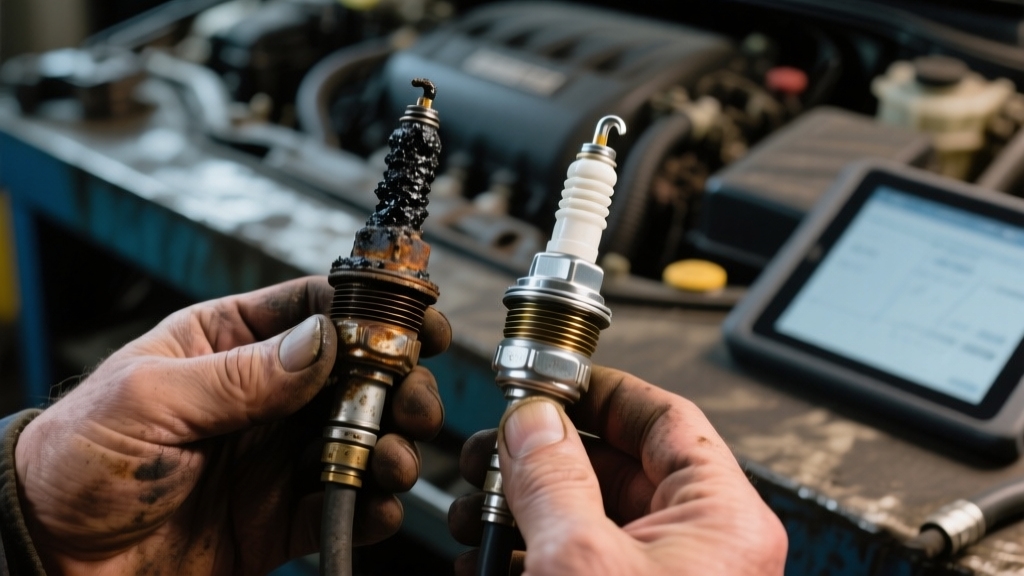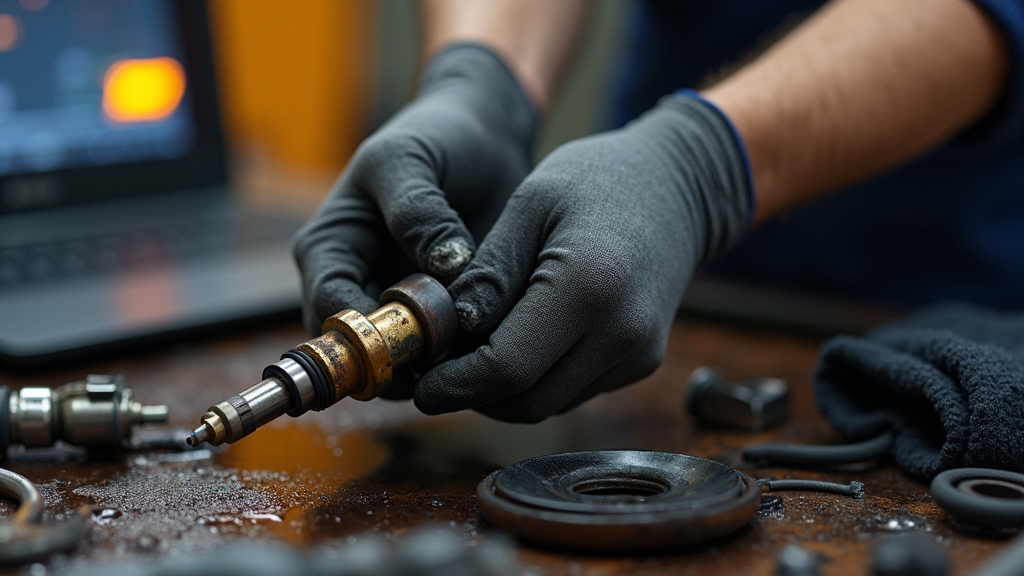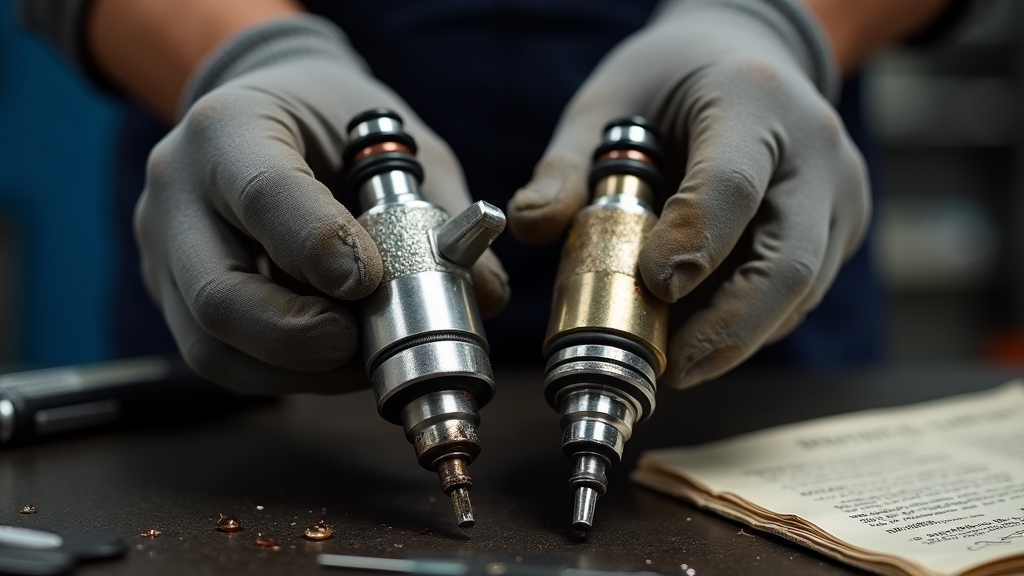Physical Address
304 North Cardinal St.
Dorchester Center, MA 02124
Physical Address
304 North Cardinal St.
Dorchester Center, MA 02124

You should change your fuel injectors if you experience consistent engine misfires, noticeable drops in fuel efficiency, rough idling, or persistent diagnostic trouble codes despite cleaning attempts.
Physical signs like leaks, corrosion, or damaged connectors also mean it’s time. Regular professional cleaning every 30,000 to 50,000 miles can extend injector life, but ignoring problems risks engine damage and higher emissions.
Understanding these factors helps you maintain peak engine performance and longevity.
Although fuel injectors are designed to last tens of thousands of miles, you should consider replacement when you notice consistent performance issues, such as decreased fuel efficiency, engine misfires, or persistent diagnostic trouble codes indicating injector faults.
Recognizing these symptoms early on is crucial because ignoring them can lead to severe engine damage. Using the correct fuel system fluids can also impact injector longevity and performance. Typically, injectors require replacement between 75,000 and 100,000 miles, especially if maintenance has been irregular.
Diagnostic scans revealing injector-specific trouble codes confirm malfunction beyond cleaning or additive treatments. Physical signs include fuel leaks, corrosion, or damaged electrical connectors detected during inspection.
Additionally, a drop in fuel economy without changes in driving habits signals injector inefficiency. If cleaning fails to restore performance, internal mechanical or electrical failure is likely. Addressing these indicators promptly prevents further engine damage and maintains ideal fuel delivery and emissions control.
When fuel injectors begin to fail, you’ll notice distinct symptoms affecting engine performance, fuel efficiency, and starting reliability. Expect engine stalls, misfires, and erratic RPM fluctuations caused by inconsistent fuel delivery disrupting combustion cycles. Erratic RPM (Tachometer) needle movement is a common sign of inconsistent fuel flow to the cylinders, which further disrupts engine stability.
You may hear knocking noises or experience acceleration delays due to improper injection timing or pressure. Fuel economy typically drops as clogged injectors impair fuel atomization, increasing exhaust emissions and causing lean mixtures that result in hesitation or stalling. Using the correct engine oil formulation can help maintain optimal injector and engine performance.
Starting the engine can become difficult or impossible when injectors fail to supply adequate fuel, especially during cold starts. Additionally, you might detect excessive exhaust smoke, unusual knocking sounds, or a strong fuel odor near the engine.
Dashboard warning lights, rough idling, and decreased throttle responsiveness further indicate injector malfunctions needing prompt attention. The check engine light often activates, signaling potential fuel injector malfunction that affects the air-to-fuel ratio.

Understanding the various causes leading to fuel injector damage is essential for diagnosing performance issues and prolonging injector lifespan. Fuel injectors face multiple threats that impair their function:
Since fuel injectors play a critical role in engine performance, accurately diagnosing their problems requires a combination of methods. Begin by scanning the ECU with an OBD2 tool to retrieve fault codes like P0200-P0208 or misfire codes P0300-P0308, which pinpoint injector issues.
Monitor fuel trim data and injector pulse commands to assess injector function in real time. Understanding the additive technology used in motor oils can also impact injector performance and longevity.
Next, perform electrical tests using a multimeter to check coil resistance (typically 10-18 ohms) and verify power supply with a noid light. Waveform analysis can detect subtle mechanical or electrical faults.
Conduct mechanical checks by inspecting for leaks, listening for injector clicks, and examining spark plugs for flooding. The fuel injection system is essential for maintaining the optimal fuel-to-air ratio, which directly affects engine efficiency and emissions.
Finally, use fuel pressure and injector balance tests to identify flow restrictions or leaks, ensuring comprehensive diagnosis before deciding on injector replacement.

Accurate diagnosis of fuel injector issues sets the stage for timely maintenance to sustain engine performance. To optimize injector lifespan, follow these recommended intervals:
Diesel injectors require more frequent attention, typically servicing or tip replacement between 37,000 to 62,000 miles, especially under harsh conditions or poor fuel quality.
Adhering to these schedules preserves fuel economy, reduces emissions, and prevents premature injector failure.
If you neglect fuel injector issues, you risk serious engine damage from irregular combustion and overheating. Abrupt loss of engine power is a common symptom caused by clogged injectors leading to irregular fuel supply. You’ll also see a significant decline in fuel economy as incomplete combustion wastes fuel, while emissions increase due to inefficient burning.
Fuel degradation, especially from oxidation and microbial contamination, can accelerate injector problems if not addressed with proper fuel storage practices. Addressing injector problems promptly helps maintain engine integrity, reduce pollutants, and optimize fuel efficiency.
When fuel injectors malfunction or become clogged, they disrupt the precise fuel delivery your engine requires, leading to uneven combustion and elevated operating temperatures. This causes critical engine damage risks you shouldn’t ignore.
Addressing injector issues promptly prevents costly repairs and maintains engine reliability. Neglecting them risks severe mechanical failures that compromise overall vehicle performance.
Although fuel injectors play a crucial role in maintaining ideal engine performance, neglecting their upkeep directly increases harmful emissions. When injectors clog or malfunction, they disrupt fuel spray patterns, causing incomplete combustion that raises hydrocarbon (HC), carbon monoxide (CO), and particulate emissions.
Fuel breakdown and contamination can damage injectors quickly, particularly in stored or infrequently used equipment, accelerating these issues due to fuel contamination. Selecting the correct hydraulic oil viscosity is similarly critical in maintaining system performance and preventing component wear.
Poor atomization leads to a rich air-fuel mixture, expelling unburned fuel and producing visible smoke and strong odors. Elevated HC emissions contribute to smog and respiratory issues, while uneven combustion temperatures from injector faults increase nitrogen oxide (NOx) output, aggravating air pollution and acid rain.
These emission spikes can cause your vehicle to fail inspections and reduce catalytic converter efficiency. Monitoring O2 and NOx sensors helps detect injector problems early, making timely maintenance essential to controlling emissions and complying with environmental regulations.
Since fuel injectors directly control the delivery and atomization of fuel into the combustion chamber, neglecting their maintenance causes a noticeable decline in fuel economy.
Dirty, clogged, or leaky injectors disrupt the precise fuel spray pattern, forcing the engine to compensate by consuming more fuel inefficiently. Maintaining proper injector function is crucial for preserving engine performance and preventing increased wear on internal components.
You’ll experience rough idling, misfires, and erratic RPMs, all symptoms of injector malfunction that increase fuel waste. Specifically, you should watch for increased fuel consumption due to overcompensation for poor atomization or leaks.
Another clear sign of injector issues is the engine misfires, causing vibrations or delayed acceleration. Engine performance issues like misfires and stalls lead to incomplete combustion. Degraded spray patterns from contamination cause the ECU to enrich fuel mixtures unnecessarily.
Replacing worn injectors restores ideal fuel delivery, improving combustion efficiency and helping you regain lost miles per gallon.
Before you begin replacing fuel injectors, you need to take several critical safety and preparatory steps to guarantee a smooth and hazard-free process. Disconnect the battery, starting with the negative terminal and relieve fuel system pressure to avoid hazards. Wear protective goggles and gloves when handling fuel lines. Consult your vehicle manual to identify necessary removals.
Next, remove obstructive components such as engine covers, intake manifolds, and wiring harnesses using proper tools. Carefully detach the fuel rail by loosening its bolts. Grasp and gently pull each injector out, managing any fuel drips.
Clean injector ports and inspect hardware for damage. Lubricate new injector O-rings, install injectors until properly seated, then reattach the fuel rail and secure bolts. Finish by reinstalling removed parts and reconnecting battery terminals.
Proper ventilation is essential during this process to minimize exposure to harmful fuel system fumes.
You’ll notice rough idling and engine vibrations when fuel injectors malfunction, disrupting the air-fuel mixture balance. This often leads to power loss symptoms, especially during acceleration or startup.
Additionally, faulty injectors reduce fuel efficiency by causing excessive fuel consumption and poor atomization. Faulty injectors can also trigger the check engine light with diagnostic codes indicating injector or circuit problems, signaling the need for inspection and repair diagnostic indicators.
When your engine idles roughly, it often signals inconsistent fuel delivery caused by faulty injectors. This inconsistency disrupts the fuel-air mixture, leading to uneven RPMs, engine vibrations, and potential stalling. Rough idling is a clear indicator of injector malfunction affecting idle stability.
You should watch for these signs:
Ignoring these symptoms increases mechanical stress on engine mounts and components, accelerating wear. To restore smooth idle, consider professional injector cleaning or replacement, especially if clogging or corrosion is severe.
Although fuel injectors are small components, their condition directly impacts your engine’s power delivery. Faulty injectors cause irregular fuel supply, leading to abrupt power loss, misfires, and erratic engine surging.
These issues disrupt the air-fuel mixture, reducing combustion efficiency and engine output. You may experience hesitation, sputtering, or unexpected stalling, all signaling injector problems requiring prompt attention. Minor clogs can sometimes be resolved with fuel injector cleaning additives, but severe blockages may need professional service or replacement.
| Symptom | Cause |
|---|---|
| Abrupt power loss | Clogged injectors |
| Engine misfires | Inconsistent fuel delivery |
| Erratic engine surging | Excess fuel from damaged injectors |
| Poor acceleration | Insufficient fuel atomization |
Since fuel injectors play a critical role in regulating the fuel-air mixture, any malfunction directly reduces fuel efficiency by causing incomplete combustion. When your injectors are faulty, they disrupt this balance, leading to higher fuel consumption and reduced miles per gallon (MPG).
You might notice your engine using more fuel without a corresponding increase in performance. Here’s what happens:
Fuel quality and contamination, such as the presence of dirt or water in diesel fuel, are common causes that clog or damage injectors, worsening fuel efficiency issues due to fuel contamination. Recognizing these symptoms early helps you maintain ideal fuel efficiency and avoid costly repairs down the line.
To prevent premature fuel injector failure, you need to maintain a clean and stable fuel system by using high-quality fuel and additives, performing regular filter maintenance, and scheduling routine injector cleanings.
Use additive-rich fuel to dissolve carbon deposits, disperse wax, and eliminate water, protecting injector components.
Additive-rich fuel cleans deposits, disperses wax, and removes water to safeguard fuel injector components.
Replace fuel and air filters per manufacturer guidelines to prevent contaminant ingress and maintain proper fuel flow. Periodic injector cleanings, either via additives or professional services, restore spray patterns and prevent clogging that impairs atomization.
Keep fuel tanks adequately filled to avoid sediment intake and cavitation erosion. Additionally, addressing electrical issues promptly helps prevent injector malfunction.
Regular engine tune-ups and inspections of seals and ignition components reduce injector stress. These steps collectively ensure ideal injector function and extend service life, helping you avoid costly premature replacements.
Aftermarket fuel injectors generally aren’t as reliable as OEM parts. While they cost less, their quality varies widely, with inconsistent flow rates and poor atomization common in cheaper units.
OEM injectors undergo rigorous testing and meet exact factory specs, ensuring consistent performance and longevity. If you want reliability, OEM is safer. Aftermarket options can work for performance tuning but require careful selection and possible engine adjustments.
Think of your vehicle as a finely tuned orchestra; each model demands unique instruments—fuel injectors—that vary in cost. Replacement expenses depend on your vehicle’s type: domestic gasoline engines are the budget-friendly violins, while diesel and luxury models are costly cellos requiring complex craftsmanship.
Labor and parts costs fluctuate with engine layout complexity and location, so expect higher prices for premium or diesel vehicles. Your injector replacement cost mirrors this intricate composition.
Yes, fuel injector problems can cause symptoms that mimic transmission issues. When injectors malfunction, they disrupt fuel flow, causing engine misfires, hesitation, and rough idling. These engine irregularities can lead to jerking, power loss, and delayed acceleration, which often resemble transmission slipping or erratic shifting.
To avoid misdiagnosis, you should first rule out injector faults using diagnostic tools before assuming transmission failure, as resolving injector issues often restores proper drivability.
It’s not safe to drive with a partially clogged fuel injector. You’ll experience engine misfires, hesitation, rough idling, and potential stalling, all of which compromise your vehicle’s performance and safety.
Erratic acceleration and power loss amplify accident risk, while prolonged use causes irreversible engine damage. Address symptoms early by cleaning or replacing injectors promptly to sustain proper fuel delivery, guarantee reliable operation, and prevent costly mechanical failures.
You should change your fuel injectors when consistent clogs, costly combustion issues, or clear performance problems persist. Ignoring injector integrity invites increased inefficiency, engine errors, and expensive repairs.
Regularly reviewing, repairing, or replacing injectors prevents premature problems and preserves peak performance. By promptly pinpointing poor patterns and practicing proper maintenance, you protect power, promote precision, and prolong your engine’s life.
Stay sharp, spot symptoms swiftly, and solve injector setbacks to sustain smooth, strong operation.